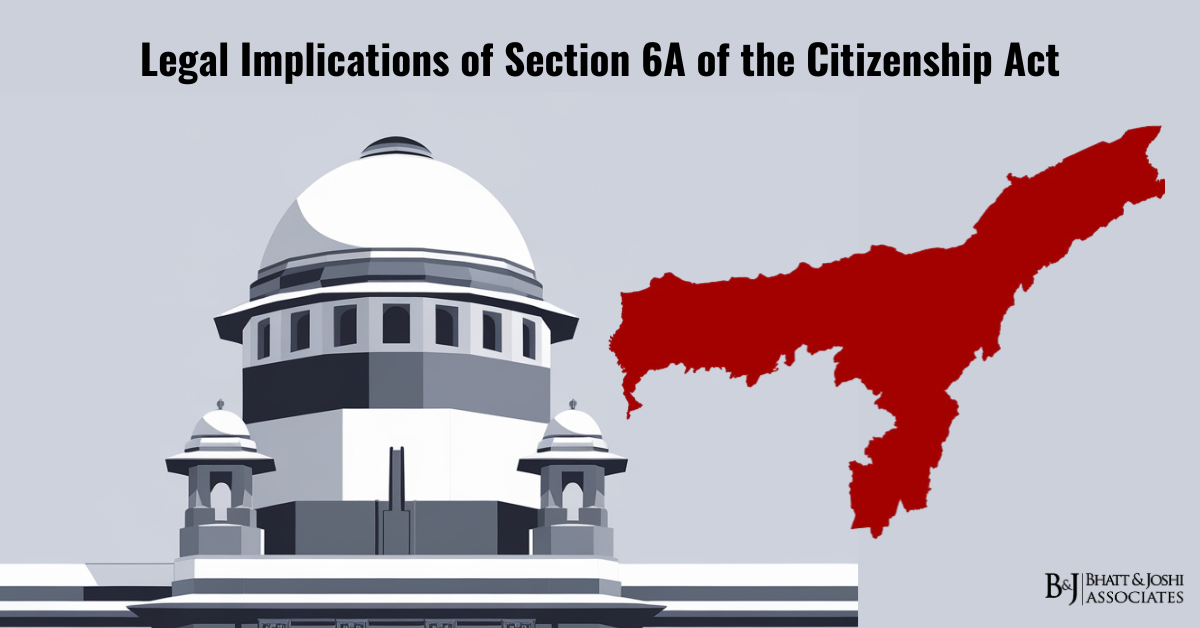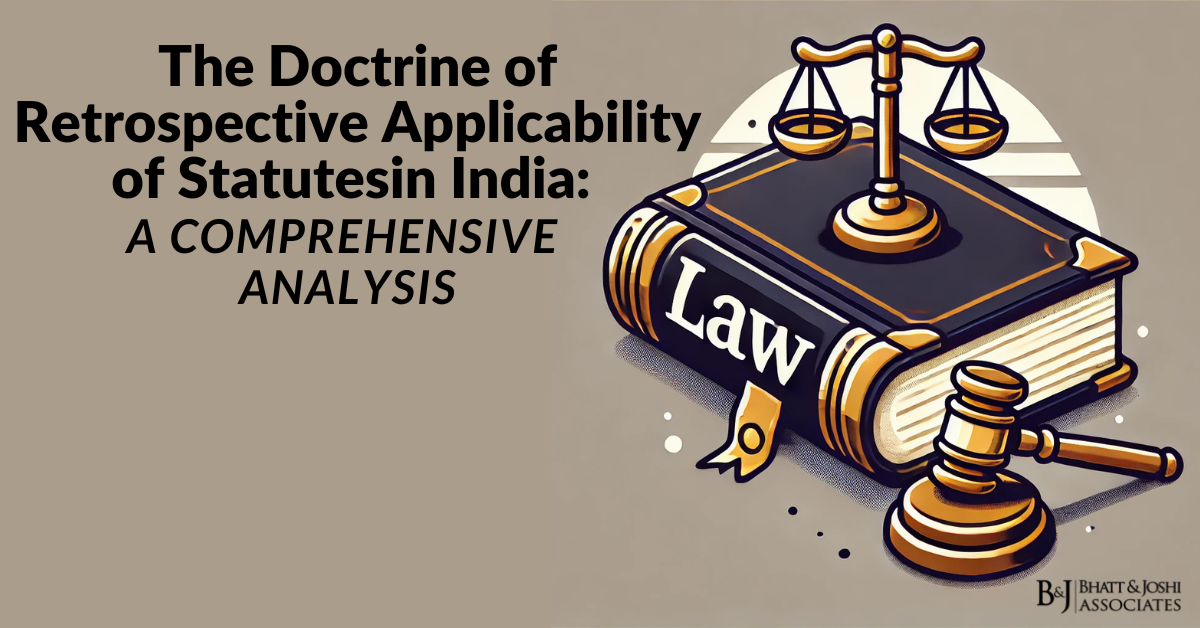Introduction
The cornerstone of the legislative framework of citizenship is the Citizenship Act of 1955. It was enacted in the initial years after India gained independence and describes how a person can acquire, lose, or even renounce citizenship. It also considers the plight of persons who are caught in the limbo of either being migrants or stateless persons. Of all its provisions, section 6A is notable for the history and socio-political circumstances that led to its enactment. It was first introduced through an amendment in 1985 to cope with the problems posed by the inflow of migrants from Bangladesh to Assam. Its origins are intimately linked to the Assam Accord, which was an important agreement directed towards addressing demographic and humanitarian issues. Over the years, Section 6A has been the focus of vigorous legal, constitutional and political controversies which it may be said to have engendered. It has created several problems concerning how to appropriately balance national security, preservation of the culture and human rights. This article focuses on the issue of section 6A of the act and its impact considering the legal context, judicial oversight, regulatory issues, and other facets of citizenship and migration which is taken with a wider angle of the issue.
Historical Background of Section 6A of the Citizenship Act
The roots of Section 6A can be traced back to the Assam Movement which was a mass agitation between 1978 and 1983 in support of against the unchecked influx of migrants from Bangladesh. In the decade when the movement was taking place indigenous Assamese populations were undergoing fears of cultural erosion and/or demographic changes as a result of the influx of Bangladeshi migrants. The movement eventually raised to virtual confrontations and led to widespread protests across Assam and disruption of traffic throughout the state which forced the Indian Government to look for a solution. The Assam Accord which was signed on the 15th August 1985 was to provide solutions to the council’s concern of the Assam Movement while also looking after the humanity of the migrants proportionately. Section 6A was included in the Citizenship Act after the Accord was introduced. This method is intended to provide a special framework for establishing the citizenship of individuals who arrived at Assam from Bangladesh during certain periods. While it was expected to be a solution to the migration crisis this provision has, in some respects, become the source of contention. By reflecting deeper problems within how law, cultural practices and human rights are managed in tandem with one another this provision highlights shortcomings in the current system.
Key Provisions of Section 6A of the Citizenship Act
Section 6A establishes separate criteria for citizenship based on the time of entry into Assam. It splits ‘migrants’ into two major categories.
Migrants who came to Assam before January 1, 1966: These people are considered Indian citizens from the time of their entry. This clause is an acknowledgement of their existence and acceptance in the state over a considerable period.
Migrants who entered between January 1, 1966, to March 25, 1971: These persons must register under the Foreigners Act of 1946. They are granted citizenship after ten years of uninterrupted residence from the date they were identified as a foreigner. In the meantime, they can enjoy most of the privileges of citizenship except voting.
Individuals who entered Assam after March 25, 1971, are classified as illegal aliens and can be removed from the country under Indian statutes. This date marks the beginning of the Bangladesh Liberation War which greatly increased the number of refugees coming into India.
Legal and Constitutional Challenges of Section 6A of the Citizenship Act
The enactment of section 6A has not addressed the complex issues involved with citizenship and migration in Assam. Instead, it has become the focal point for legal and constitutional challenges. Critics of the provision argue that it creates a concentration of concerns on equality, justice and the protection of Indigenous rights.
Unequal Treatment of Migrants
The most significant challenge to Section 6A is that it sets up a special regime for Assam different from the rest of India. While other states fall under the uniform provisions of the Citizenship Act, Section 6A has Provisions for specific regions which view migrants in Assam, differently. This has caused claims of inequity, with opponents believing that it contravenes the constitutional discrimination of equality in Article 14.
Threat to Indigenous Rights
The liberal elements within Section 6A designed for the granting of citizenship have generated deep concern over fears of cultural displacement and demographic change among the Assamese native population. Critics believe that the large-scale social naturalisation of migrants undermines the constitutional charge to preserve the cultural and linguistic identity of minority communities under Articles 29 and 30. This matter has served as a rallying point for political and social movements in Assam.
Inconsistency with National Policy
Section 6A is problematic because it strays too far from India’s national policy on unauthorized immigration. The Supreme Court found the Illegal Migrants Determination by Tribunal (IMDT) Act of 1983 unconstitutional because it set up a simplistic process for determining illegal immigration into Assam. Still, Section 6A has been described as equally liberal which raises doubts concerning the consistency of India’s immigration legislation.
Judicial Interpretation and Key Judgments
The judiciary has been at the forefront in undertaking the debates concerning Section 6A. A number of them have been issued regarding its constitutionality and its effects on Indian society as a whole, including its implementation.
Sarbananda Sonowal V. Union of India (2005)
In this case, the Supreme Court IMDT Act is unconstitutional arbitrary and discriminatory because of its provisions. The Court observed that the Act’s permits were so generous that it became impossible to identify and remove unlawful aliens, which endangered our national security. While Section 6A was not the focus of the dispute in this case, the ruling emphasized the liberal approach to illegal migration posed by Assam and required action.
Assam Sanmilita Mahasangha V. Union of India (2014)
This case is directly about the dispute about the constitutionality of the 6A clause. The petitioners claimed that the clause infringes the rights of the indigenous Assami people by naturalizing immigrants of different origins. In 2015 The Supreme Court decided that the case had considerable importance in other issues of national stability so they directed it to a Constitution Bench. The case is still standing, which marks the legal confusion on the 6A clause.
Anwar Ali Sarkar Case (1952)
Though not directly related to Section 6A, this case is relevant to the construction of Article 14 of the Constitution. The Supreme Court stated that any law which creates classification may do so only on the basis of intelligible differentia and must have a rational nexus with the purpose that is sought to be accomplished. This has been consistently used in discussions with the regional discriminations made by Section 6A.
Regulatory Framework and Implementation
The execution of Section 6A is based on a system of interlocking regulation that employs both legislative and administrative strategies. Important components of this system are:
The Foreigners Act of 1946
Migrants wanting citizenship under Section 6A are required to register themselves under the Act which, along with other laws, enables the detection, detention, and deportation of illegal aliens. This Act permits for the state to record the presence of foreigners and check their compliance with immigration regulations.
The National Register of Citizens (NRC)
The NRC is an important register for distinction between citizens and illegal residents. The revision of the NRC in Assam in 2019 created debates across the country because it disenfranchised more than 1.9 million people, a large number of who were tossed into legal non-personhood. The implementation of the NRC has revealed the problems of precision, inclusivity, and equity.
Foreigners Tribunals
These are multi-chamber boards of limited jurisdiction entitled to consider the cases for citizenship under Section 6A that possess features of a court. These tribunals have been subject to criticism because their procedures are secretive, their criteria are vague, and their error rates are crippling. There is no resolution on these matters concerning their effectiveness and justice.
Policy and Humanitarian Issues
Section 6A engages in issues relating to national security in tandem with humanitarian considerations. A considerable number of migrants entering Assam from Bangladesh were being persecuted, which puts India’s position in international law under scrutiny. India is not a signatory of the 1951 Refugee Convention, but it has to observe the principle of non-refoulement, which forbids the return of people to places where there is a high possibility of persecution. Critics contend that the deportation provisions in Section 6A violate this principle.
It is a difficult task to integrate some of these humanitarian considerations with the protection of indigenous people’s rights and national security. Policymaking must remain sensitive to the reasonable apprehensions of the Assamese communities and the rights of the migrants some populations that are vulnerable.
Recent Developments in Citizenship Laws in India
The Citizenship (Amendment) Act 2019 (CAA) has substantially brought an extra level of complexity to the old discussion occurring over Section 6A of the Citizenship Act. The CAA provides a path through citizenship for small non-Muslim minority groups from Pakistan, Afghanistan and Bangladesh that entered the country before December 31, 2014. Although the CAA does not amend 6A of the Citizenship Act it creates so many overlapping provisions that legality and confusion are occurring. The interplay between the CAA and 6A of the Citizenship Act has intensified political and legal debates in the country leading to the argument of critics amongst themselves that it sharpens existing tensions between minorities and the majority Indian population. The Citizenship (Amendment) Act 2019 (CAA) has substantially added to the already complex disruption of the debate relating to Section 6A of the Citizenship Act. CAA creates a pathway of citizenship for minor non-Muslim groups in Pakistan, Afghanistan and Bangladesh that entered the country before December 31, 2014. Although the CAA does not directly amend Section 6A of the Citizenship Act there is overlap in the provisions of the two laws which has led to confusion of the legal challenges of the matter. The debate on the relationship and way 2A and CAA interact has increased the political and legal tensions across the country with critics of the argue that it has sharpened existing tensions between minorities and the majority Indian population.
Conclusion
The complications in Section 6A of the Citizenship Act illustrate how to balance historical wounds, cultural imprints, and humanitarian logic. Although it was meant to address the migration issue in Assam, it has erupted into a plethora of legal and constitutional conflicts. The division’s regional contours, demographic consequences, and its relationship with the general policies on citizenship have provoked public discourse across the country.
While the Supreme Court Constitution bench is still pondering over it’s legitimacy, Section 6A is still up in the air. Its answer will universally impact how legal, social, and political questions in India coexist, and nurture the precedent for citizenship laws, migration, and flourishing sociocultural heterogeneity in the country.














